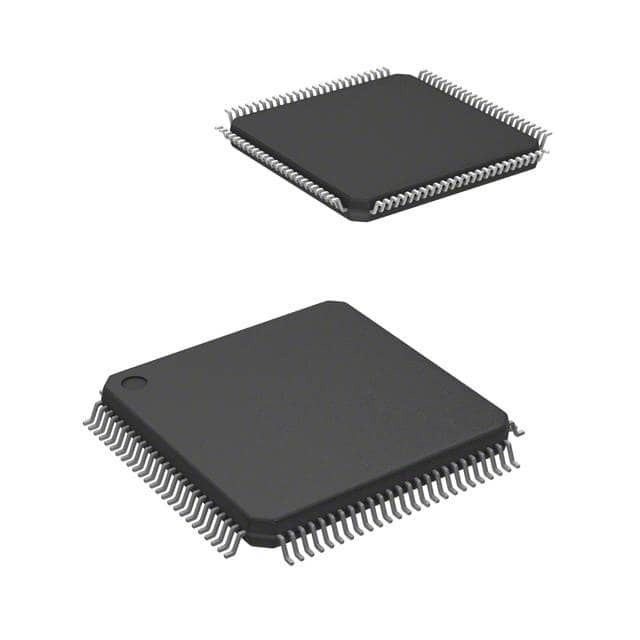Xem thông số kỹ thuật để biết chi tiết sản phẩm.

MB91F524FWCPMC-GSE1
Product Overview
- Category: Microcontroller
- Use: Embedded systems, automotive applications
- Characteristics: High-performance, low-power consumption, compact size
- Package: LQFP (Low-profile Quad Flat Package)
- Essence: Advanced microcontroller for automotive control systems
- Packaging/Quantity: Tray packaging, 100 units per tray
Specifications
- Architecture: ARM Cortex-M3
- Clock Speed: Up to 80 MHz
- Flash Memory: 512 KB
- RAM: 64 KB
- Operating Voltage: 2.7V - 5.5V
- I/O Pins: 48
- Communication Interfaces: CAN, LIN, UART, SPI, I2C
- Analog Inputs: 12-bit ADC with 16 channels
- Timers/Counters: 16-bit and 32-bit timers/counters
- Operating Temperature: -40°C to +105°C
Detailed Pin Configuration
The MB91F524FWCPMC-GSE1 microcontroller has a total of 48 I/O pins. The pin configuration is as follows:
- Pins 1-8: General-purpose I/O pins
- Pins 9-16: Analog input pins
- Pins 17-24: Communication interface pins (CAN, LIN, UART, SPI, I2C)
- Pins 25-32: Timer/counter pins
- Pins 33-40: Power supply and ground pins
- Pins 41-48: Reserved for future use
Functional Features
- High-performance ARM Cortex-M3 core for efficient processing
- Low-power consumption for extended battery life in automotive applications
- Wide operating voltage range for compatibility with various power sources
- Multiple communication interfaces for seamless integration with other systems
- Advanced analog input capabilities for precise sensor measurements
- Timers/counters for accurate timing and event management
Advantages and Disadvantages
Advantages: - High-performance processing capabilities - Low-power consumption for energy-efficient applications - Compact size for space-constrained designs - Wide operating voltage range for flexibility - Multiple communication interfaces for versatile connectivity - Advanced analog input capabilities for accurate sensor readings
Disadvantages: - Limited flash memory and RAM compared to some other microcontrollers - Relatively higher cost compared to entry-level microcontrollers
Working Principles
The MB91F524FWCPMC-GSE1 microcontroller operates based on the ARM Cortex-M3 architecture. It executes instructions stored in its flash memory, processes data, and controls various peripherals and interfaces. The microcontroller interacts with external devices through its I/O pins and communication interfaces, enabling it to perform tasks such as automotive control, sensor data acquisition, and communication with other systems.
Detailed Application Field Plans
The MB91F524FWCPMC-GSE1 microcontroller is widely used in automotive applications, including:
- Engine Control Units (ECUs)
- Body Control Modules (BCMs)
- Transmission Control Units (TCUs)
- Anti-lock Braking Systems (ABS)
- Airbag Control Units (ACUs)
- Infotainment Systems
- Climate Control Systems
Its high-performance processing capabilities, low-power consumption, and compatibility with various communication protocols make it suitable for these demanding automotive applications.
Detailed and Complete Alternative Models
- MB91F524FWCPMC-GSE2: Similar to MB91F524FWCPMC-GSE1 but with increased flash memory capacity (1 MB) and additional I/O pins.
- MB91F524FWCPMC-GSE3: Enhanced version with extended temperature range (-40°C to +125°C) for harsh automotive environments.
- MB91F524FWCPMC-GSE4: Lower-cost variant with reduced flash memory capacity (256 KB) and fewer I/O pins.
These alternative models provide options based on specific project requirements, offering variations in memory capacity, temperature range, and cost.
Liệt kê 10 câu hỏi và câu trả lời thường gặp liên quan đến ứng dụng MB91F524FWCPMC-GSE1 trong giải pháp kỹ thuật
Sure! Here are 10 common questions and answers related to the application of MB91F524FWCPMC-GSE1 in technical solutions:
Q1: What is MB91F524FWCPMC-GSE1? A1: MB91F524FWCPMC-GSE1 is a microcontroller unit (MCU) manufactured by Fujitsu. It is designed for use in automotive applications and offers various features and peripherals.
Q2: What are the key features of MB91F524FWCPMC-GSE1? A2: Some key features of MB91F524FWCPMC-GSE1 include a high-performance 32-bit RISC CPU, on-chip flash memory, multiple communication interfaces, analog-to-digital converters, and various timers.
Q3: What are the typical applications of MB91F524FWCPMC-GSE1? A3: MB91F524FWCPMC-GSE1 is commonly used in automotive systems such as engine control units (ECUs), body control modules (BCMs), powertrain control modules (PCMs), and other electronic control units (ECUs).
Q4: Can MB91F524FWCPMC-GSE1 be used in non-automotive applications? A4: While MB91F524FWCPMC-GSE1 is primarily designed for automotive applications, it can also be used in other industrial control systems, home automation, and similar embedded applications.
Q5: What programming language is used for MB91F524FWCPMC-GSE1? A5: MB91F524FWCPMC-GSE1 is typically programmed using C or assembly language. Fujitsu provides development tools and software libraries to facilitate programming and development.
Q6: Is MB91F524FWCPMC-GSE1 suitable for real-time applications? A6: Yes, MB91F524FWCPMC-GSE1 is suitable for real-time applications due to its high-performance CPU, interrupt handling capabilities, and various timers.
Q7: Can MB91F524FWCPMC-GSE1 communicate with other devices? A7: Yes, MB91F524FWCPMC-GSE1 supports multiple communication interfaces such as UART, SPI, I2C, and CAN, allowing it to communicate with other devices or systems.
Q8: Does MB91F524FWCPMC-GSE1 have built-in analog-to-digital converters (ADCs)? A8: Yes, MB91F524FWCPMC-GSE1 has on-chip ADCs, which can be used to measure analog signals from sensors or other external devices.
Q9: What is the maximum clock frequency of MB91F524FWCPMC-GSE1? A9: The maximum clock frequency of MB91F524FWCPMC-GSE1 is typically 80 MHz, providing high-speed processing capabilities.
Q10: Are there any development tools available for MB91F524FWCPMC-GSE1? A10: Yes, Fujitsu provides development tools such as compilers, debuggers, and integrated development environments (IDEs) specifically designed for programming and debugging MB91F524FWCPMC-GSE1-based applications.
Please note that these answers are general and may vary depending on specific requirements and application scenarios.

